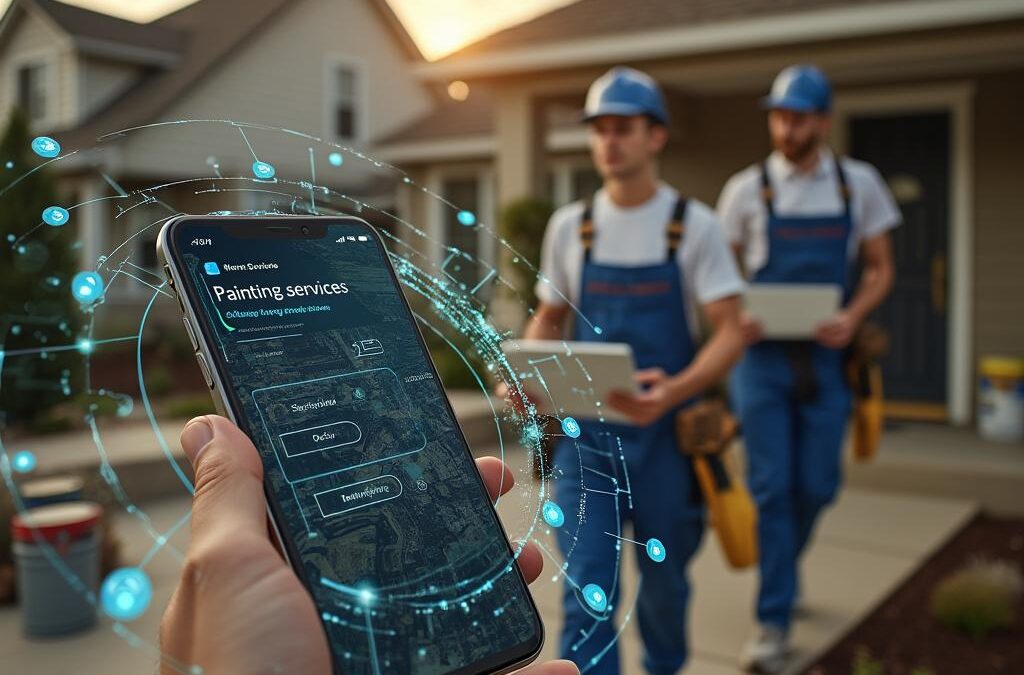Technology is transforming the home services industry, an area that has long resisted innovation compared to sectors like retail and transportation. Richard Kilgannon calls this space technology’s “last frontier.”
Traditional home service experiences—like hiring a contractor for painting, plumbing, or cleaning—have often been slow, uncertain, and stressful. Unlike ordering a car or shopping online, finding and securing home services has remained manual and fragmented.
But this is changing. Companies are adopting digital-first approaches to streamline every aspect, from initial estimates to job completion. One standout example is Arch Painting, an industry leader using big data, automation, and software platforms to revolutionize the painting market.
Through its acquisition of Paintzen, an on-demand painting service, Arch Painting leverages cutting-edge tools like AI, satellite imagery, and drones. These technologies enable faster, more accurate estimates, quick online bookings, and rapid deployment of service crews.
The benefits for consumers are clear: greater speed, transparency, and convenience. However, this transformation also raises important questions about its impact on independent contractors and small businesses.
As technology reshapes the home services industry, one thing is certain: the sector is finally catching up to the digital age, bringing with it both opportunities and challenges for all stakeholders.
Key technological advancements in home services include instant estimates, online booking and tracking, rapid response times, and platform integration. These innovations are reshaping how consumers interact with service providers, making the process more efficient and transparent.
Instant estimates are a game-changer, enabling customers to receive same-day pricing for residential projects and quick turnaround for commercial jobs. This is achieved through digital platforms that analyze project details using satellite images and AI, eliminating the need for in-person visits that often delay the process.
Online booking and tracking have also become standard, allowing customers to schedule services, monitor job progress, and receive real-time updates. This level of convenience and transparency is a significant improvement over traditional methods, where communication was often inconsistent and unreliable.
Rapid response times are another hallmark of this digital transformation. Arch Painting, for instance, can complete some projects before competitors even provide a quote, with crews often arriving onsite within 24 hours of an order. This speed is a direct result of technology-driven efficiencies in scheduling and resource allocation.
Platform integration is further enhancing the home services experience. Partnerships, such as the one between EXIT Realty New England and Paintzen, enable real estate agents to prepare properties for sale quickly by scheduling painting services online. This collaboration ensures that a crew arrives within five days of booking, streamlining the process for all parties involved.
These advancements bring numerous benefits for consumers, including greater speed and reliability in securing home improvement services, increased transparency and accuracy in pricing, and easier, tech-enabled interaction throughout the process. However, this transformation also raises important questions about its impact on the industry.
One major concern is the potential for market consolidation. Critics argue that platforms like Paintzen, backed by large companies, could reduce opportunities for independent contractors and small businesses. This could make the market less accessible to new entrants, potentially stifling competition and innovation.
Another challenge is the automation of processes like estimating and scheduling, which may threaten traditional jobs in the industry. As AI and digital tools replace roles previously performed manually, there is growing concern about the future of employment in this sector.
Looking ahead, industry experts like Richard Kilgannon believe that these changes reflect broader consumer trends. As people become more comfortable with digital transactions in other areas of life, such as buying cars or booking vacations online, they are increasingly expecting the same level of convenience when arranging home upgrades.
However, the industry is closely watching whether this digital transformation will create new opportunities or deepen the divide between large firms and smaller independents. While technology is undoubtedly leveling up the home services sector, the long-term impact on all industry participants remains to be seen.
Conclusion
The home services industry is undergoing a significant transformation driven by technology, marking a shift from traditional, manual processes to digital-first solutions. Companies like Arch Painting and Paintzen are leading the charge, leveraging AI, satellite imagery, and automation to deliver faster, more transparent, and convenient services. While these advancements bring undeniable benefits to consumers, they also raise important questions about the future of independent contractors and small businesses in the industry.
As technology continues to reshape the home services landscape, it is clear that the sector is finally embracing the digital age. Whether this transformation fosters greater opportunities or exacerbates existing challenges remains to be seen. One thing is certain, however: the home services industry will never be the same.
Frequently Asked Questions
How is technology changing the home services industry?
Technology is streamlining processes like instant estimates, online booking, and rapid response times. Companies are using AI, satellite imagery, and automation to make services faster, more transparent, and convenient for consumers.
What are the benefits of digital transformation for consumers?
Consumers benefit from faster service delivery, transparent pricing, and real-time tracking of jobs. Digital platforms also reduce the need for in-person visits, making the process more efficient.
Will technology replace independent contractors?
While technology may consolidate the market and automate certain tasks, it also creates new opportunities. Independent contractors can adapt by embracing digital tools and partnering with platforms to remain competitive.
How do I choose between traditional and digital home services?
Consider your priorities. Digital services offer speed and convenience, while traditional services may provide more personalized, hands-on experiences. Research both options to find the best fit for your needs.
What does the future of the home services industry look like?
The industry is expected to become more digitized, with a focus on efficiency and transparency. However, the balance between large platforms and independent contractors will likely evolve, shaping the future landscape.

